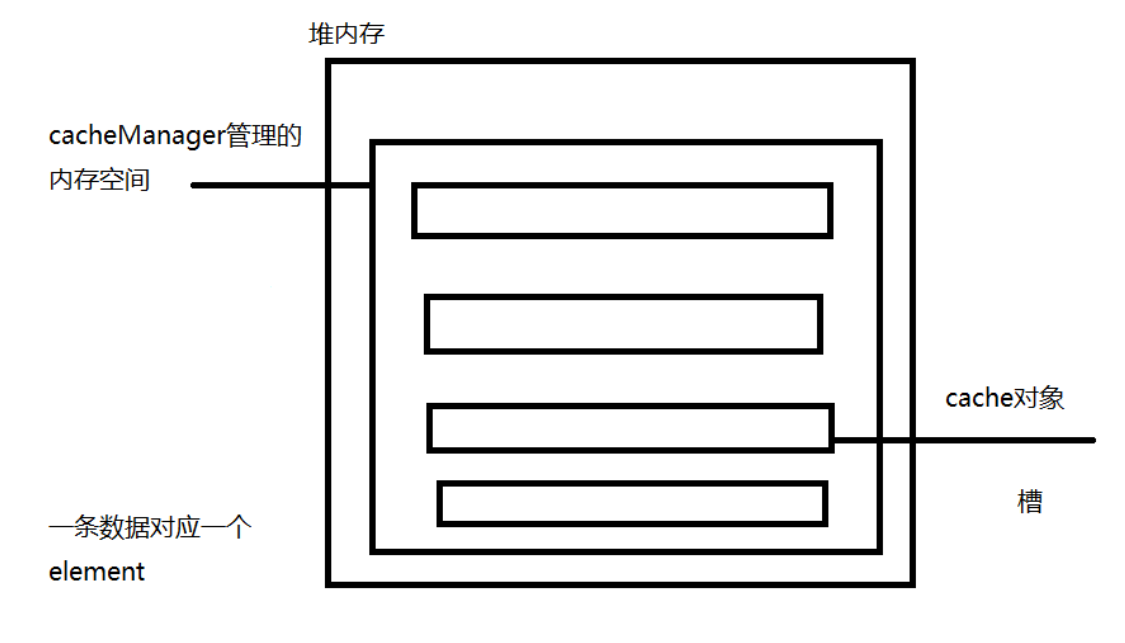为什么需要缓存?
使用缓存,是需要对应用系统进行性能优化而常采用的一种重要手段。合理地运用缓存,可以极大的提高应用系统的运行效率。
Hibernate的二级缓存由SessionFactory对象管理,是应用级别的缓存。它可以缓存整个应用的持久化对象,所以又称为“SessionFactory缓存”。
hibernate二级缓存中的缓存对象可以被整个应用的Session对象共享,即使关闭当前Session对象,新建的Session对象仍可使用。使用Hibernate的二级缓存之后查询数据,Session对象会首先在以及缓存中查找有无缓存数据被命中。如果没有,则查找二级缓存。如果有,则直接返回所命中的数据;否则查询数据库。
关系型数据库:数据与数据之间存在关系(联系)的数据库 mysql/Oracle、sqlserver
非关系型数据库:数据与数据之间是不存在关系的,key-value
1、基于文件存储的数据库:ehcache
2、基于内存存储的数据库:redis、memcache
3、基于文档存储的数据库:mongodb
4. ehcache的特点
4.1 够快
Ehcache的发行有一段时长了,经过几年的努力和不计其数的性能测试,Ehcache终被设计于large, high concurrency systems.
4.2 够简单
开发者提供的接口非常简单明了,从Ehcache的搭建到运用运行仅仅需要的是你宝贵的几分钟。其实很多开发者都不知道自己用在用Ehcache,Ehcache被广泛的运用于其他的开源项目
4.3 够袖珍
关于这点的特性,官方给了一个很可爱的名字small foot print ,一般Ehcache的发布版本不会到2M,V 2.2.3 才 668KB。
4.4 够轻量
核心程序仅仅依赖slf4j这一个包,没有之一!
4.5 好扩展
Ehcache提供了对大数据的内存和硬盘的存储,最近版本允许多实例、保存对象高灵活性、提供LRU、LFU、FIFO淘汰算法,基础属性支持热配置、支持的插件多
4.6 监听器
缓存管理器监听器 (CacheManagerListener)和 缓存监听器(CacheEvenListener),做一些统计或数据一致性广播挺好用的
4.7 分布式缓存
从Ehcache 1.2开始,支持高性能的分布式缓存,兼具灵活性和扩展性
使用ehcache缓存框架需要引入依赖与桥接包
pom.xml:
<project xmlns="http://maven.apache.org/POM/4.0.0" xmlns:xsi="http://www.w3.org/2001/XMLSchema-instance" xsi:schemaLocation="http://maven.apache.org/POM/4.0.0 http://maven.apache.org/maven-v4_0_0.xsd"> <modelVersion>4.0.0</modelVersion> <groupId>com.lww</groupId> <artifactId>T224_hibernate</artifactId> <packaging>war</packaging> <version>0.0.1-SNAPSHOT</version> <name>T224_hibernate Maven Webapp</name> <url>http://maven.apache.org</url> <properties> <project.build.sourceEncoding>UTF-8</project.build.sourceEncoding> <maven.compiler.source>1.8</maven.compiler.source> <maven.compiler.target>1.8</maven.compiler.target> <junit.version>4.12</junit.version> <servlet.version>4.0.0</servlet.version> <hibernate.version>5.2.12.Final</hibernate.version> <mysql.driver.version>5.1.46</mysql.driver.version> <ehcache.version>2.10.0</ehcache.version> <slf4j-api.version>1.7.7</slf4j-api.version> <log4j-api.version>2.9.1</log4j-api.version> </properties> <dependencies> <dependency> <groupId>junit</groupId> <artifactId>junit</artifactId> <version>${junit.version}</version> <scope>test</scope> </dependency> <dependency> <groupId>javax.servlet</groupId> <artifactId>javax.servlet-api</artifactId> <version>${servlet.version}</version> <scope>provided</scope> </dependency> <dependency> <groupId>org.hibernate</groupId> <artifactId>hibernate-core</artifactId> <version>${hibernate.version}</version> </dependency> <dependency> <groupId>mysql</groupId> <artifactId>mysql-connector-java</artifactId> <version>${mysql.driver.version}</version> </dependency> <dependency> <groupId>net.sf.ehcache</groupId> <artifactId>ehcache</artifactId> <version>${ehcache.version}</version> </dependency> <dependency> <groupId>org.hibernate</groupId> <artifactId>hibernate-ehcache</artifactId> <version>${hibernate.version}</version> </dependency> <!-- slf4j核心包 --> <dependency> <groupId>org.slf4j</groupId> <artifactId>slf4j-api</artifactId> <version>${slf4j-api.version}</version> </dependency> <dependency> <groupId>org.slf4j</groupId> <artifactId>jcl-over-slf4j</artifactId> <version>${slf4j-api.version}</version> <scope>runtime</scope> </dependency> <!--用于与slf4j保持桥接 --> <dependency> <groupId>org.apache.logging.log4j</groupId> <artifactId>log4j-slf4j-impl</artifactId> <version>${log4j-api.version}</version> </dependency> <!--核心log4j2jar包 --> <dependency> <groupId>org.apache.logging.log4j</groupId> <artifactId>log4j-api</artifactId> <version>${log4j-api.version}</version> </dependency> <dependency> <groupId>org.apache.logging.log4j</groupId> <artifactId>log4j-core</artifactId> <version>${log4j-api.version}</version> </dependency> </dependencies> <build> <finalName>T224_hibernate</finalName> <plugins> <plugin> <groupId>org.apache.maven.plugins</groupId> <artifactId>maven-compiler-plugin</artifactId> <version>3.7.0</version> <configuration> <source>${maven.compiler.source}</source> <target>${maven.compiler.target}</target> <encoding>${project.build.sourceEncoding}</encoding> </configuration> </plugin> </plugins> </build> </project>
工具类 EhcacheUtil:
package com.liuwenwu.six.util; import net.sf.ehcache.Cache; import net.sf.ehcache.CacheManager; import net.sf.ehcache.Element; import java.io.InputStream; public class EhcacheUtil { private static CacheManager cacheManager; static { try { InputStream is = EhcacheUtil.class.getResourceAsStream("/ehcache.xml"); cacheManager = CacheManager.create(is); } catch (Exception e) { throw new RuntimeException(e); } } private EhcacheUtil() { } public static void put(String cacheName, Object key, Object value) { Cache cache = cacheManager.getCache(cacheName); if (null == cache) { //以默认配置添加一个名叫cacheName的Cache cacheManager.addCache(cacheName); cache = cacheManager.getCache(cacheName); } cache.put(new Element(key, value)); } public static Object get(String cacheName, Object key) { Cache cache = cacheManager.getCache(cacheName); Element element = cache.get(key); return null == element ? null : element.getValue(); } public static void remove(String cacheName, Object key) { Cache cache = cacheManager.getCache(cacheName); cache.remove(key); } }
ehcache内存结构

缓存配置文件 ehcache.xml
<?xml version="1.0" encoding="UTF-8"?> <ehcache xmlns:xsi="http://www.w3.org/2001/XMLSchema-instance" xsi:noNamespaceSchemaLocation="http://ehcache.org/ehcache.xsd" updateCheck="false"> <!--磁盘存储:将缓存中暂时不使用的对象,转移到硬盘,类似于Windows系统的虚拟内存--> <!--path:指定在硬盘上存储对象的路径--> <!--java.io.tmpdir 是默认的临时文件路径。 可以通过如下方式打印出具体的文件路径 System.out.println(System.getProperty("java.io.tmpdir"));--> <diskStore path="D://xxx"/> <!--defaultCache:默认的管理策略--> <!--eternal:设定缓存的elements是否永远不过期。如果为true,则缓存的数据始终有效,如果为false那么还要根据timeToIdleSeconds,timeToLiveSeconds判断--> <!--maxElementsInMemory:在内存中缓存的element的最大数目--> <!--overflowToDisk:如果内存中数据超过内存限制,是否要缓存到磁盘上--> <!--diskPersistent:是否在磁盘上持久化。指重启jvm后,数据是否有效。默认为false--> <!--timeToIdleSeconds:对象空闲时间(单位:秒),指对象在多长时间没有被访问就会失效。只对eternal为false的有效。默认值0,表示一直可以访问--> <!--timeToLiveSeconds:对象存活时间(单位:秒),指对象从创建到失效所需要的时间。只对eternal为false的有效。默认值0,表示一直可以访问--> <!--memoryStoreEvictionPolicy:缓存的3 种清空策略--> <!--FIFO:first in first out (先进先出)--> <!--LFU:Less Frequently Used (最少使用).意思是一直以来最少被使用的。缓存的元素有一个hit 属性,hit 值最小的将会被清出缓存--> <!--LRU:Least Recently Used(最近最少使用). (ehcache 默认值).缓存的元素有一个时间戳,当缓存容量满了,而又需要腾出地方来缓存新的元素的时候,那么现有缓存元素中时间戳离当前时间最远的元素将被清出缓存--> <defaultCache eternal="false" maxElementsInMemory="1000" overflowToDisk="false" diskPersistent="false" timeToIdleSeconds="0" timeToLiveSeconds="600" memoryStoreEvictionPolicy="LRU"/> <!--name:槽的名字 Cache的名称,必须是唯一的(ehcache会把这个cache放到HashMap里)--> <cache name="com.liuwenwu.one.entity.User" eternal="false" maxElementsInMemory="100" overflowToDisk="true" diskPersistent="true" timeToIdleSeconds="0" timeToLiveSeconds="300" memoryStoreEvictionPolicy="LRU"/> </ehcache>
利用map集合简易实现缓存原理
EhcacheDemo1:
package com.liuwenwu.six.test; import java.util.HashMap; import java.util.Map; /** * 利用map集合简易实现缓存原理 * @author Administrator * */ public class EhcacheDemo1 { // 在Java虚拟机的静态区中开了一个空间 static Map<String, Object> cache = new HashMap<String, Object>(); static Object getValue(String key) { Object value = cache.get(key); System.out.println("从缓存中获取数据....."); if(value == null) { System.out.println("从软件箱对应的配置文件(数据库)中获取数据....."); cache.put(key, new String[] {"zs"}); return cache.get(key); } return value; } public static void main(String[] args) { System.out.println(getValue("sname")); System.out.println(getValue("sname")); // 从缓存中获取数据..... // 从软件箱对应的配置文件(数据库)中获取数据..... // "zs" // 从缓存中获取数据..... // "zs" } }
当数据量过大,我们可以将缓存数据存入指定文件夹 虽然都是从硬盘中取数据,但不需要经过数据库,提升了性能 适用于变动较少的数据
<diskStore path="D://xxx"/> 存放位置 overflowToDisk="true" diskPersistent="true"
EhcacheDemo2;
package com.liuwenwu.six.test; import com.liuwenwu.six.util.EhcacheUtil; /** * 演示利用缓存存储数据 * @author Administrator * */ public class EhcacheDemo2 { public static void main(String[] args) { System.out.println(System.getProperty("java.io.tmpdir")); EhcacheUtil.put("com.liuwenwu.one.entity.User", 11, "zhangsan"); System.out.println(EhcacheUtil.get("com.liuwenwu.one.entity.User", 11)); } }
成功将数据存入指定文件夹

hibernate一级缓存:
/** * 同一个session,sql语句只生成一次,这里用到了一级缓存 * session级别的缓存就是一级缓存 * SessionFactory级别的缓存是二级缓存 * 默认一级缓存是开启的 */ public static void test1() { Session session = SessionFactoryUtils.openSession(); Transaction transaction = session.beginTransaction(); User user = session.get(User.class, 1); System.out.println(user); User user2 = session.get(User.class, 1); System.out.println(user2); User user3 = session.get(User.class, 1); System.out.println(user3); transaction.commit(); session.close(); }
同一个session,sql语句只生成一次,这里用到了一级缓存,但当使用多个session是,sql语句也会形成多次,为了提高性能,必须使用二级缓存SessionFactory缓存
开启二级缓存
<!-- 开启二级缓存 -->
<property name="hibernate.cache.use_second_level_cache">true</property>
<!-- 开启查询缓存 -->
<property name="hibernate.cache.use_query_cache">true</property>
<!-- EhCache驱动 -->
<property name="hibernate.cache.region.factory_class">org.hibernate.cache.ehcache.EhCacheRegionFactory</property>
在对应的映射文件中添加缓存标记 User.hbm.xml
<!-- 添加缓存标号 指定槽 --> <cache usage="read-write" region="com.liuwenwu.one.entity.User"/>
调用方法
public static void main(String[] args) { UserDao userDao = new UserDao(); User u = new User(); u.setId(1); User user = userDao.get(u); System.out.println(user); User user2 = userDao.get(u); System.out.println(user2); User user3 = userDao.get(u); System.out.println(user3); // test1(); }
sql语句只执行了一次,二级缓存开启成功
Hibernate: select user0_.id as id1_7_0_, user0_.user_name as user_nam2_7_0_, user0_.user_pwd as user_pwd3_7_0_, user0_.real_name as real_nam4_7_0_, user0_.sex as sex5_7_0_, user0_.birthday as birthday6_7_0_, user0_.create_datetime as create_d7_7_0_, user0_.remark as remark8_7_0_ from t_hibernate_user user0_ where user0_.id=? 2019-07-21 11:17:29.056 [main-434] DEBUG net.sf.ehcache.store.disk.Segment - put added 0 on heap User [id=1, userName=三毛, userPwd=123, sex=男, birthday=2019-07-13, realName=毛三, createDatetime=2019-07-13 18:35:11.0, remark=111] User [id=1, userName=三毛, userPwd=123, sex=男, birthday=2019-07-13, realName=毛三, createDatetime=2019-07-13 18:35:11.0, remark=111] User [id=1, userName=三毛, userPwd=123, sex=男, birthday=2019-07-13, realName=毛三, createDatetime=2019-07-13 18:35:11.0, remark=111] 2019-07-21 11:17:29.076 [com%002eliuwenwu%002eone%002eentity%002e%0055ser.data-764] DEBUG net.sf.ehcache.store.disk.Segment - fault removed 0 from heap 2019-07-21 11:17:29.076 [com%002eliuwenwu%002eone%002eentity%002e%0055ser.data-776] DEBUG net.sf.ehcache.store.disk.Segment - fault added 0 on disk
EhcacheDemo4:
package com.liuwenwu.six.test; import java.util.List; import org.hibernate.Session; import org.hibernate.Transaction; import org.hibernate.query.Query; import com.liuwenwu.two.util.SessionFactoryUtils; /** * hibernate二级缓存开启后: * 默认会对查询出的单条记录使用缓存机制 * 并不会对查询出的多条记录使用二级缓存机制 * 查询出多条记录的时候,想使用二级缓存的话,还需要通过代码去开启 * * hibernate针对单条数剧和多条数剧使用二级缓存为什么会存在差异性 * * @author Administrator * */ public class EhcacheDemo4 { public static void main(String[] args) { Session session = SessionFactoryUtils.openSession(); Transaction transaction = session.beginTransaction(); Query query = session.createQuery("from User"); // query.setCacheable(true); List list = query.list(); System.out.println(list); List list2 = query.list(); System.out.println(list2); List list3 = query.list(); System.out.println(list3); transaction.commit(); session.close(); } }
hibernate针对单条数剧和多条数剧使用二级缓存为什么会存在差异性
查询出多条记录的时候,数据量过大,为节约虚拟机内存,默认不开启缓存,想使用二级缓存的话,还需要通过代码去开启
query.setCacheable(true);